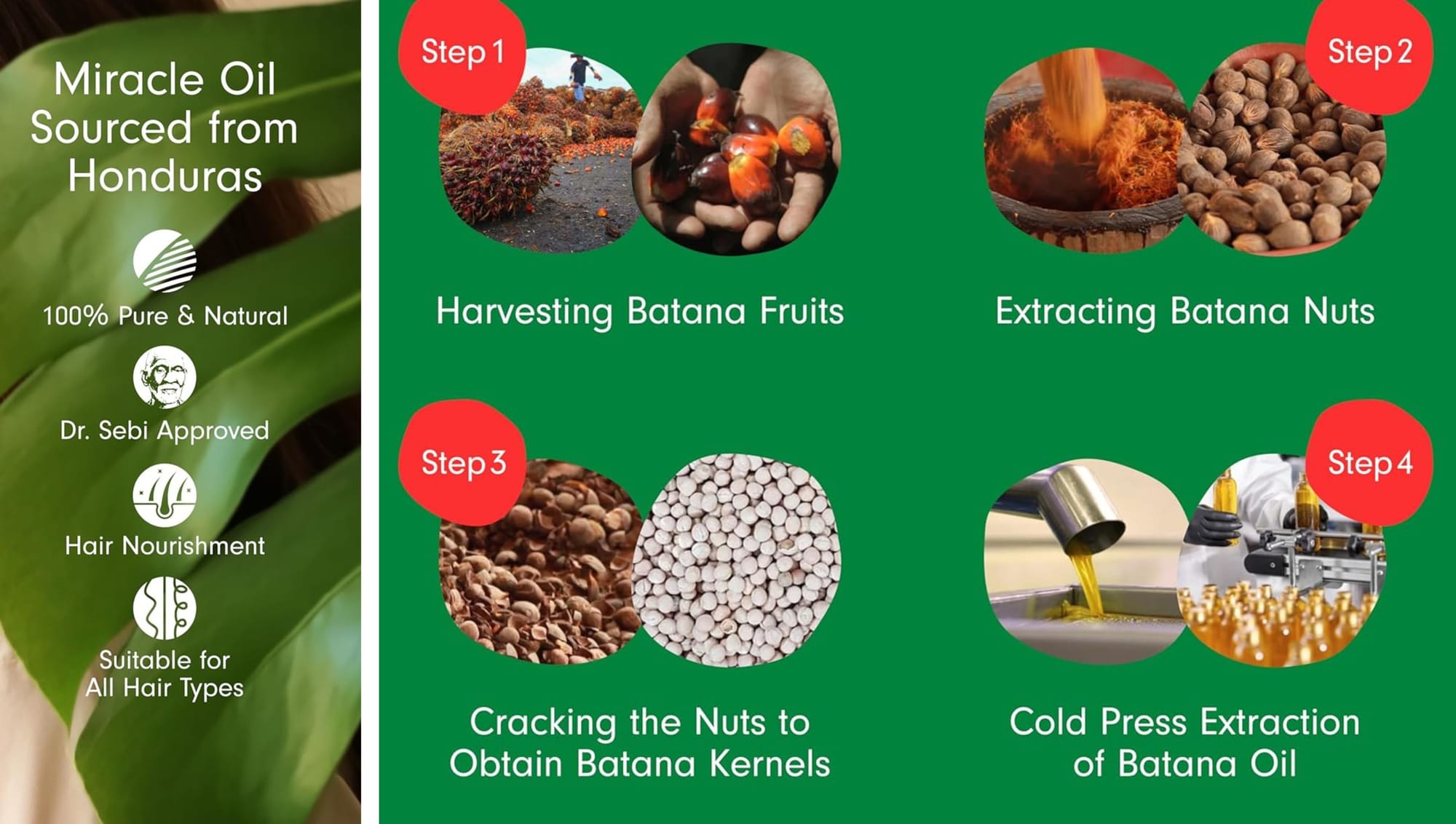How to Tell if Batana Oil is Real or Fake
Checking these details ensures you choose genuine Batana Oil for the best benefits to your hair and skin.

Key Takeaways:
- Understanding Authentic Batana Oil: Learn the key characteristics of genuine Batana Oil.
- Identifying Fake Batana Oil: Discover the common signs of counterfeit products.
- Practical Tips for Verification: Get actionable advice on how to verify the authenticity of Batana Oil.
Introduction to Batana Oil
Batana Oil, often hailed as a miracle oil, is derived from the American palm tree, Elaeis oleifera. This oil is renowned for its ability to rejuvenate hair and skin, making it a sought-after product in the beauty industry. However, with its rising popularity, the market has seen an influx of counterfeit products. Knowing how to distinguish real Batana Oil from fake is crucial for anyone looking to reap its benefits.
The Origins of Batana Oil
Batana Oil is primarily produced by the indigenous Miskito people of Honduras. They have been using this oil for centuries, referring to it as "the miracle oil" due to its remarkable properties. The traditional extraction process involves roasting the palm nuts, which gives the oil its characteristic dark brown color and nutty aroma.
The Unique Properties of Batana Oil
Genuine Batana Oil is rich in essential fatty acids, vitamins, and antioxidants. These components contribute to its effectiveness in promoting hair growth, repairing damaged hair, and moisturizing the skin. The oil's unique composition sets it apart from other oils, making it a valuable addition to any beauty regimen.
The Importance of Authenticity
Using fake Batana Oil can lead to disappointing results and potential skin or hair issues. Counterfeit products often lack the beneficial properties of genuine Batana Oil and may contain harmful additives. Therefore, ensuring the authenticity of the oil is essential for achieving the desired outcomes.
Recognizing Genuine Batana Oil
Color and Consistency
Real Batana Oil has a dark brown color, almost resembling chocolate. Its consistency is thick and viscous, unlike many other oils that are lighter and more fluid. If the oil you have is pale or watery, it's likely not genuine Batana Oil.
Aroma
The scent of Batana Oil is distinctive, with a nutty and earthy aroma. This smell is a result of the traditional roasting process. If the oil has a chemical or artificial fragrance, it is probably fake.
Packaging and Labeling
Source Information
Authentic Batana Oil will often mention its origin, specifically referencing the Miskito people or Honduras. This information is a good indicator of the oil's authenticity. Always check the label for such details.
Certification and Seals
Look for certifications or seals of authenticity on the packaging. These can include organic certifications or endorsements from reputable organizations. Such seals add credibility to the product.
Price Point
Too Good to Be True
Batana Oil is a premium product, and its price reflects its quality and the labor-intensive extraction process. If you come across Batana Oil that is significantly cheaper than the average market price, it is likely a counterfeit.
Market Research
Conducting market research can help you understand the typical price range for Batana Oil. This knowledge will enable you to make informed purchasing decisions and avoid falling for fake products.
Seller Reputation
Trusted Vendors
Purchasing from reputable vendors or directly from sources known for selling authentic Batana Oil is advisable. Established sellers are less likely to offer counterfeit products.
Customer Reviews
Reading customer reviews can provide insights into the authenticity of the oil. Positive feedback from verified buyers is a good sign that the product is genuine.
Testing the Oil
Patch Test
Performing a patch test can help determine the oil's authenticity. Apply a small amount of the oil to your skin and observe any reactions. Genuine Batana Oil should not cause irritation or adverse effects.
Hair Test
Applying the oil to a small section of your hair can also be revealing. Real Batana Oil will leave your hair feeling nourished and soft. If the oil feels greasy or causes dryness, it may be fake.
Storage and Shelf Life
Proper Storage
Authentic Batana Oil should be stored in a cool, dark place to maintain its properties. Exposure to light and heat can degrade the oil. If the oil you have deteriorates quickly, it might not be genuine.
Shelf Life
Genuine Batana Oil has a relatively long shelf life due to its natural antioxidants. If the oil spoils quickly or develops an off smell, it could be a sign of a counterfeit product.
Common Adulterants
Dilution with Other Oils
One common method of counterfeiting Batana Oil is diluting it with cheaper oils. This practice reduces the oil's effectiveness. Checking the ingredient list can help identify any added oils.
Synthetic Additives
Some counterfeit products contain synthetic additives to mimic the properties of Batana Oil. These additives can be harmful and reduce the oil's natural benefits. Always opt for products with minimal and natural ingredients.
Visual Inspection
Sediment and Particles
Authentic Batana Oil may contain some natural sediment due to the traditional extraction process. However, excessive particles or cloudiness can indicate contamination or poor quality.
Clarity
While Batana Oil is thick, it should still have a certain level of clarity. If the oil appears overly cloudy or has an unusual texture, it might be fake.
The Role of Certifications
Organic Certification
Organic certification is a strong indicator of authenticity. Certified organic Batana Oil is free from harmful chemicals and additives, ensuring you get a pure product.
Fair Trade Certification
Fair Trade certification ensures that the oil is produced ethically, supporting the indigenous communities who make it. This certification adds another layer of credibility to the product.
The Impact of Fake Batana Oil
Health Risks
Using counterfeit Batana Oil can pose health risks, including skin irritation and allergic reactions. These risks arise from the harmful additives often found in fake products.
Ineffectiveness
Fake Batana Oil lacks the beneficial properties of the genuine product, leading to ineffective results. This can be frustrating and a waste of money for consumers seeking the oil's benefits.
Practical Tips for Verification
Buy from Reputable Sources
Always purchase Batana Oil from reputable sources or directly from the producers. This reduces the risk of buying counterfeit products.
Check for Authenticity Seals
Look for authenticity seals and certifications on the packaging. These indicators can help verify the oil's genuineness.
Conclusion
Ensuring the authenticity of Batana Oil is crucial for reaping its numerous benefits. By understanding the key characteristics of genuine Batana Oil and being aware of the common signs of counterfeit products, you can make informed purchasing decisions. Always buy from reputable sources, check for certifications, and perform simple tests to verify the oil's authenticity.
Summary
Batana Oil is a highly sought-after product known for its remarkable benefits for hair and skin. However, the market is flooded with counterfeit products that lack the genuine properties of real Batana Oil. By understanding the unique characteristics of authentic Batana Oil, such as its color, aroma, and consistency, and by purchasing from reputable sources, you can ensure you are getting the real deal. Always check for certifications and perform simple tests to verify the oil's authenticity.
If you're ready to incorporate Batana Oil into your health routine and appreciate its unique benefits, click the button below and keep reading to discover the Batana Oil we've selected for you to try.

